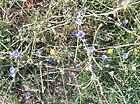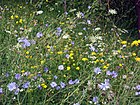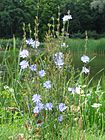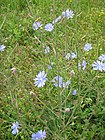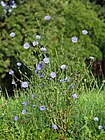Note: This is a project under development. The articles on this wiki are just being initiated and broadly incomplete. You can Help creating new pages.
Difference between revisions of "Cichorium intybus"
| (One intermediate revision by the same user not shown) | |||
| Line 1: | Line 1: | ||
[[File:C. intybus flor-2.JPG|thumb|right]] | [[File:C. intybus flor-2.JPG|thumb|right]] | ||
| + | '''Cichorium intybus''' is a perennial plant that can grow up to 1.50 metres tall. | ||
| + | It is harvested from the wild for local use as a food, medicine and source of materials. | ||
==Uses== | ==Uses== | ||
| − | {{Uses|}}, {{Uses|}}, {{Uses|}}, {{Uses|}}, {{Uses| | + | {{Uses|Jaundice}}, {{Uses|Liver enlargement}}, {{Uses|Gout}}, {{Uses|Rheumatism}}, {{Uses|Gravel}}. |
==Parts Used== | ==Parts Used== | ||
| − | {{Parts Used|}}, {{Parts Used| | + | {{Parts Used|Leaves}}, {{Parts Used|Roots}}, {{Parts Used|Flowers}}. |
==Chemical Composition== | ==Chemical Composition== | ||
| Line 16: | Line 18: | ||
===Dravya=== | ===Dravya=== | ||
===Rasa=== | ===Rasa=== | ||
| − | |||
===Guna=== | ===Guna=== | ||
| Line 29: | Line 30: | ||
==Habit== | ==Habit== | ||
| − | {{Habit|}} | + | {{Habit|Perennial}} |
==Identification== | ==Identification== | ||
| Line 48: | Line 49: | ||
==Mode of Propagation== | ==Mode of Propagation== | ||
| − | {{Propagation|}} | + | {{Propagation|Seeds}} |
==How to plant/cultivate== | ==How to plant/cultivate== | ||
| − | <ref name="How to plant/cultivate"/> | + | Prefers a sunny position in any moderately fertile well-drained moisture retentive soil.<ref name="How to plant/cultivate"/> |
==Commonly seen growing in areas== | ==Commonly seen growing in areas== | ||
| − | {{Commonly seen|}}, {{Commonly seen|}}, {{Commonly seen| | + | {{Commonly seen|Grassy meadows}}, {{Commonly seen|Arable land}}, {{Commonly seen|Especially on chalk}}. |
==Photo Gallery== | ==Photo Gallery== | ||
| Line 71: | Line 72: | ||
<references> | <references> | ||
| − | <ref name="chemical composition">[" | + | <ref name="chemical composition">[Chemistry]</ref> |
| + | |||
| + | <ref name="Leaf">[Morphology]</ref> | ||
| − | <ref name=" | + | <ref name="How to plant/cultivate">[http://temperate.theferns.info/plant/Cichorium+intybus Cultivation]</ref> |
| − | |||
| − | |||
</references> | </references> | ||
==External Links== | ==External Links== | ||
| − | * [ ] | + | * [https://pfaf.org/user/plant.aspx?LatinName=Cichorium+intybus Cichorium intybus on pfaf.org] |
| − | * [ | + | * [https://www.sciencedirect.com/topics/agricultural-and-biological-sciences/cichorium-intybus Cichorium intybus on sciencedirect.com] |
| − | |||
[[Category:Herbs]] | [[Category:Herbs]] | ||
[[Category:Pages without herbs images]] | [[Category:Pages without herbs images]] | ||
Latest revision as of 16:52, 15 April 2020
Cichorium intybus is a perennial plant that can grow up to 1.50 metres tall. It is harvested from the wild for local use as a food, medicine and source of materials.
Contents
- 1 Uses
- 2 Parts Used
- 3 Chemical Composition
- 4 Common names
- 5 Properties
- 6 Habit
- 7 Identification
- 8 List of Ayurvedic medicine in which the herb is used
- 9 Where to get the saplings
- 10 Mode of Propagation
- 11 How to plant/cultivate
- 12 Commonly seen growing in areas
- 13 Photo Gallery
- 14 References
- 15 External Links
Uses
Jaundice, Liver enlargement, Gout, Rheumatism, Gravel.
Parts Used
Chemical Composition
Common names
| Language | Common name |
|---|---|
| Kannada | |
| Hindi | |
| Malayalam | |
| Tamil | |
| Telugu | |
| Marathi | |
| Gujarathi | |
| Punjabi | |
| Kashmiri | |
| Sanskrit | |
| English |
Properties
Reference: Dravya - Substance, Rasa - Taste, Guna - Qualities, Veerya - Potency, Vipaka - Post-digesion effect, Karma - Pharmacological activity, Prabhava - Therepeutics.
Dravya
Rasa
Guna
Veerya
Vipaka
Karma
Prabhava
Habit
Identification
Leaf
| Kind | Shape | Feature |
|---|---|---|
Flower
| Type | Size | Color and composition | Stamen | More information |
|---|---|---|---|---|
| {{{5}}} |
Fruit
| Type | Size | Mass | Appearance | Seeds | More information |
|---|---|---|---|---|---|
Other features
List of Ayurvedic medicine in which the herb is used
Where to get the saplings
Mode of Propagation
How to plant/cultivate
Prefers a sunny position in any moderately fertile well-drained moisture retentive soil.[3]
Commonly seen growing in areas
Grassy meadows, Arable land, Especially on chalk.
Photo Gallery
References
- ↑ [Chemistry]
- ↑ [Morphology]
- ↑ Cultivation
External Links
Categories:
- Ayurvedic Herbs known to be helpful to treat Jaundice
- Ayurvedic Herbs known to be helpful to treat Liver enlargement
- Ayurvedic Herbs known to be helpful to treat Gout
- Ayurvedic Herbs known to be helpful to treat Rheumatism
- Ayurvedic Herbs known to be helpful to treat Gravel
- Herbs with Leaves used in medicine
- Herbs with Roots used in medicine
- Herbs with Flowers used in medicine
- Habit - Perennial
- Index of Plants which can be propagated by Seeds
- Herbs that are commonly seen in the region of Grassy meadows
- Herbs that are commonly seen in the region of Arable land
- Herbs that are commonly seen in the region of Especially on chalk
- Herbs
- Pages without herbs images

